Since I'd be going as far as New York, I decided to take a side trip to Arctic Canada.
My plane landed on a gravel airstrip in a fjord. Staying with an Inuit family, I ate caribou and arctic char, learned all about their way of life, and found it very different from mine.
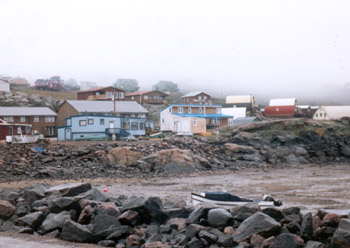
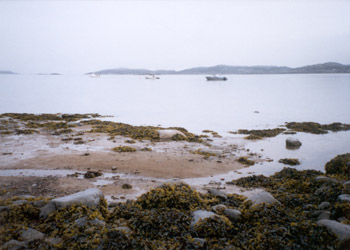
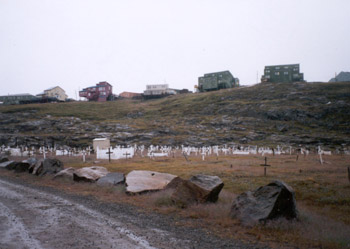
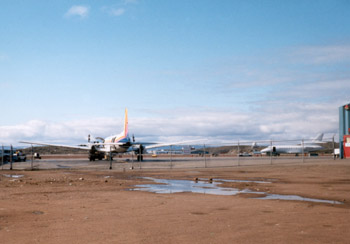
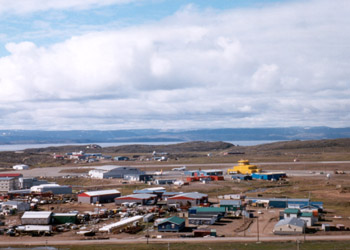
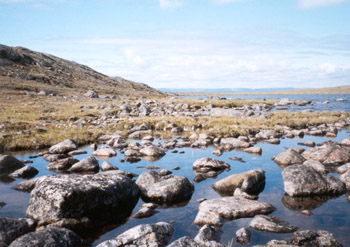
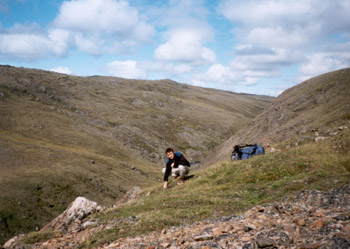
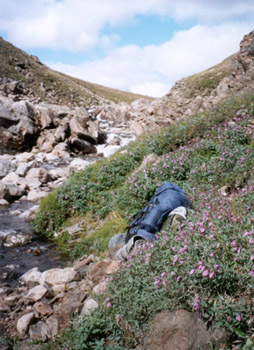
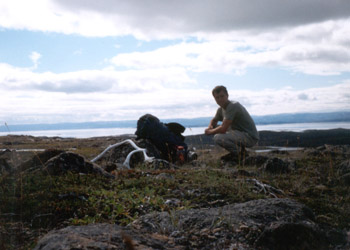
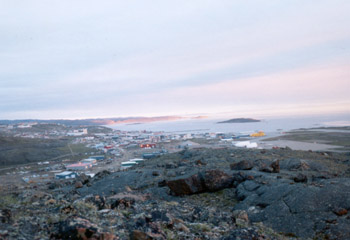


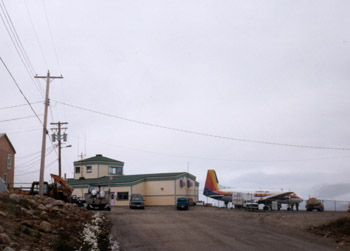
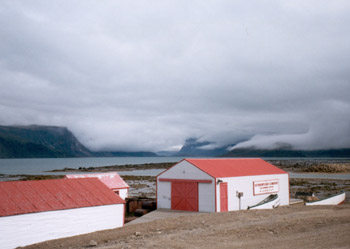

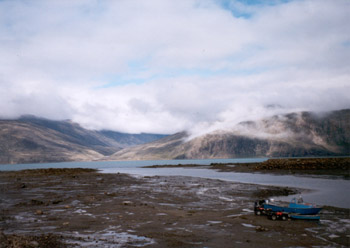

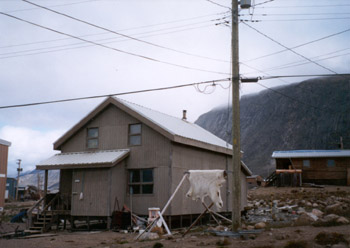
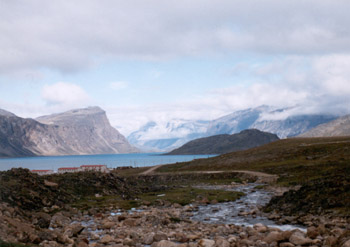
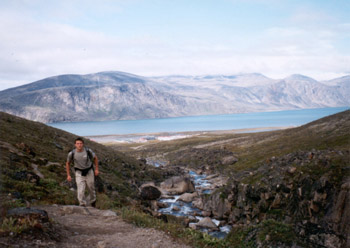
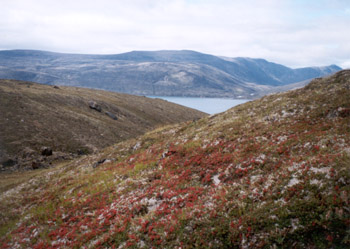
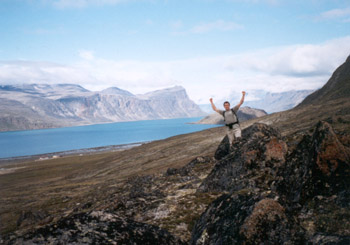
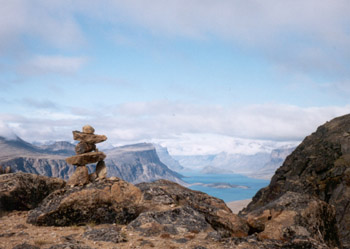
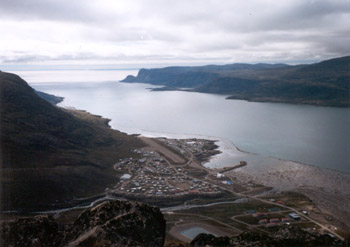
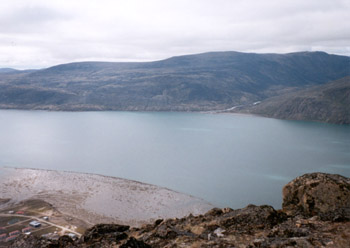
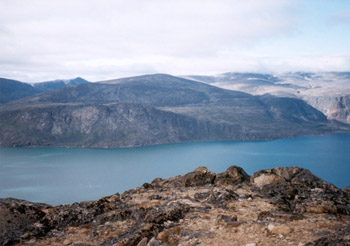
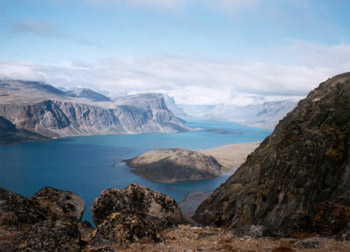

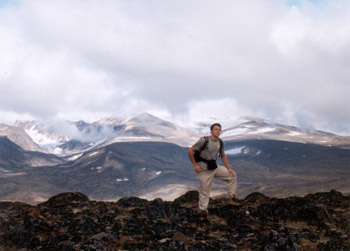


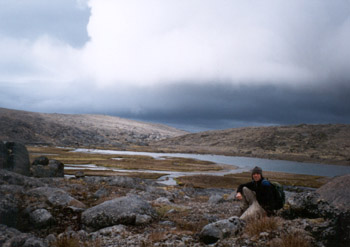
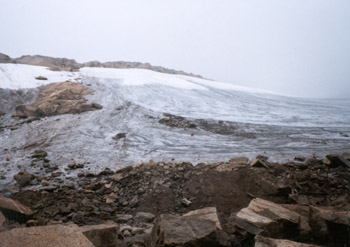

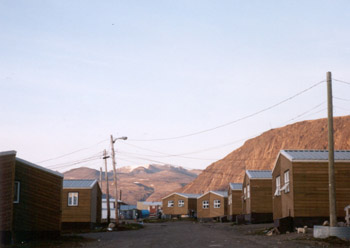
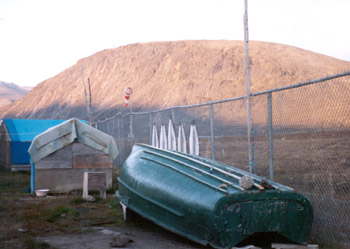
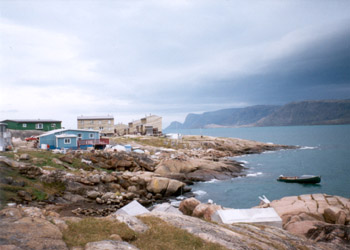
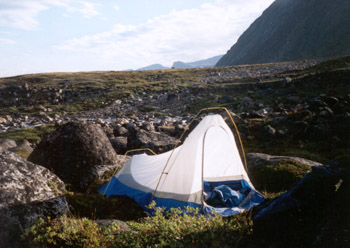
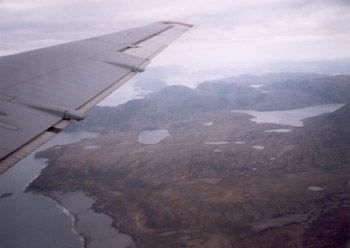
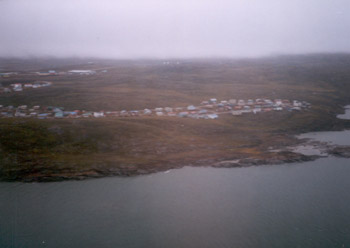
I was going back to New York to see the family for a weekend, but it seemed a long way to go for such a short visit so I searched for a side trip. I found one, looking at my globe: the city of Iqaluit on Baffin Island. It's high (about 64 degrees up), remote (locked in by sea ice for 9 months of the year and accessible only by air or sea), and the gateway to the Canadian Arctic. I booked passage immediately via Ottawa and, a month later, was slogging through light rain on my way to find lodging. After a couple days in Iqaluit I hopped on a plane going farther north to Pangnirtung, a smaller village on a fjord with a gravel airstrip surrounded by rugged mountains. There I stayed with an Inuit family, ventured out into the surrounding hills, and wandered through town watching and listening and learning.
Ottawa has an attractive airport, comprised of angled tubular steel columns and trusses, glass, abundant fountains and rock-lined splash pools, polished maple trim, potted plants, white translucent countertops, and stonework of white blocks evoking a Northern ice environment. I slept there one night - actually, it's more correct to say "rested there" after arriving late from Los Angeles en route to Iqaluit, capital of Nunavut. To the unaware Southerner, the Nunavut sounds like something out of Gulliver's Travels but this newest of Canada's provinces is home to twenty-five thousand Inuit and the animals that they pursue by boat, sled, ATV, truck, and occasionally on foot or with dogs in the traditional way. I spotted the place on my globe and booked passage north to investigate. Iqaluit (pronounced "eeHAllowit" or "eeHAlloweet", or "ihKAllowit" if you're a southern transplant mispronouncing the Inuktitut) is in the Barren Lands, a place where not a single tree grows and the sea ice is out for only a few months of the year. It's the largest town in the region but it didn't hold my attention, so a couple days after arriving in the wet mosquito-bitten place I was again airborne in the back of a Hercules 748 turboprop, headed to the short gravel airstrip in a beautiful fjord at Pangnirtung. That name's pronounced "PAngnuktuk" or "PAngnuktung" and commonly referred to as Pang. Inuktitut speech is a pretty sound, a syllabilic language without well-defined words that flows together but is spoken with double-consonant breaks that sometimes make it seem that the speaker is choking on a piece of fish.. I stayed a few days with an Inuit family, dining on caribou and Arctic char from the previous week's hunting trip, venturing out into the fjord in their aluminum boat fitted with two Honda 90's, and walking all over town and the surrounding hills. I found a beautiful but desolate land, carpeted with wildflowers and blueberries and lakes and ice fields, windy and free of mosquitoes and all wildlife but birds. Even the birds fled at my sight. Every creature is hunted. The people are troubled, many suffering from the collapse of their traditional simple lifestyles and unable to adapt to the ways of the South. The North is Canada's great welfare state, a place where city costs and prices lurk in rustic villages and few sources of income are available. I watched icebergs drift past in the sound and waited for breaks of sunny weather to catch glimpses of the rugged peaks to the North, hiking to hilltops and ice sheets or strolling through town watching the people, browsing the stores, and reading historical references at the Visitor Center. Skins were strung on fences and hung over porch railings, bright red fillets of char joined at the tail hung over wooden poles to dry in the sun, antlers and tusks lay piled atop sheds, a polar bear hide swayed in the breeze as it hung from a line, and adorable furry puppies raced among the older dogs chasing one another around the streets. Pang is a small town housing about 1500 people in small government houses perched atop steel piles drilled into the permafrost. It was a good place to see, but I had trouble leaving when windy weather arrived. After a day's delay a plane made it in, and when it departed with me aboard we porpoised like a boat and fishtailed like a car driving on icy roads. My checked bag vanished after customs in Ottawa but I've returned home with film and stories to share.
On my flight to Pittsburg one of the stewardesses kept asking "Would you like some food please?" "A drink, please?" with absolute sincerity. I didn't know what to make of it. The clouds over Indiana looked like soapsuds with swirling trails left by someone trailing fingers in the foam. There was a pretty sunset on the mashed potato plain; darkness fell as we landed. Later, as we descended into Ottawa in a mostly empty regional jet, I scrutinized the patterns of lights below to ascertain the possibility of camping a short distance from the airport. Finding comfortable and sheltered chairs in the main lobby, and seeing the wet weather outside, I stayed in but I think I would have been happier had I trekked across the road to a stand of trees and pitched my tent. The tent was blue, however, too bright for anonymity... but the new tent is drab green, the perfect color for such things. A ground crew thief has made a small grab, probably less rich in expensive gear than he had hoped. Sadly, most everyone I have met looks favorably upon some level of thievery, deception, or fraud as long as they are on the profit side. Most even suggest that I pad my insurance claims to break even over the deductible or make a profit. I think most everyone is a thief at times - so think twice before sympathizing with me: what would you do?
The girl at Immigration said "What are you going to do there?" I said, "I have no idea." "Why are you going?" "I found it on a map." "That's an expensive place to go with no idea." I smiled and shrugged. She looked like she may have once lived up north. Many other people looked distinctly British or French. It was interesting how noticeably different people are though they live only hundreds of kilometers apart. That's one of the first things that seeps into a traveler's awareness - that beyond the USA melting pot, or even just beyond the well-mixed urban centers of the States, tribes still exist overlaid by governments. People from the next county or country over are distinctly different, grown uniquely by the land and time just like wine grapes and fine cheese. It is good to appreciate such variance. Go and look for it yourself. At 3am the floor buffers, machines like riding lawnmowers, whirred through every corner of my brain. At 5:00 people started to arrive. At 6:30 I washed up and found an ATM and checked my bag to Iqaluit, bought a muffin and drank some water, and watched the first games of the Olympics on a big screen across the terminal. In the waiting area near the gate I glanced at other passengers, wondering where they were going up North. Did they live there? Why? Inuit families with shopping bags and armadas of plastic storage tubs appeared to be returning home. Caucasian couples with immense heaps of crated belongings at the check desk must also have been returning to work in Nunavut. In the airport, I noticed a fair number of Inuit-looking people pushing trash cans and mops, doing the blue collar work. Canada's workers come from the North, and the States' come from the South - of course, because there are oceans east and west and deserts North and South.
First Air departed unhurried about 20 minutes late with an old 727. The forward half was closed off by a bulkhead and packed with cargo, large pallets of boxes draped in nets, so we entered the aircraft by stairs that dropped down from the tail. I sat next to a man whose name I never asked. I'll call him Rob. He was born in Ontario but his father moved to Cape Dorset to take a carpentry and village maintenance job when Rob was young. It was supposed to be for a year, but twenty five years later Rob had never left, was married, and still worked there - in Iqaluit - keeping an electrical trade. He gave some advice on what to see in the area but I was rather surprised both by how ordinary his attitude to life up north was - in spite of the long flight - and by how sheltered he was. The two are most certainly related. Rob had traveled all over the North - Nunavut and the Northwest Territories and he knew all the villages, but he was no expert on tourism and couldn't offer me a pitch of what I wanted to see in his homeland. He spoke like a Scot, with long pronounced Canadian "...eh?" interjections at every point of emphasis. I took a copy of the Nunitsiaq News and read page after page of "us versus them" articles lamenting the town putting up new street signs with manes not everyone liked, of the signs insecure and liable to cause harm in heavy winds, of various homeless Inuks being wronged by the system in Montreal and Ottawa, of a pregnant Greenlander cast out because she wasn't covered under the health care agreement, and so forth. The paper was fully bilingual in English and Inuktitut, the characters of the latter language written in syllabics adapted from Cree syllabary in the 1870s by Anglican missionaries John Horden and E.A. Watkins and brought to the Arctic by their colleague Edmund Peck to facilitate the teaching of their religion. The Cree characters in turn were developed in the 1840s by Methodist missionary James Evans for the same purpose. Advertisements at the back showed an abundance of jobs, many offering $60K to $100K Cdn. (at about $1.35 Cdn to the USD), yet the articles still complained of poverty and insufficient social support. By the end of the week, I acquired a sound opinion that the people of the North are narrow minded, unmotivated, and poor workers by nature.
On a brighter note, at the start of this realization and my conversations with Rob I became quite excited to be dropping into such a different, distant, revealing place of great beauty representing a vast land area of the planet. It was a doorway open to a new unseen place about which I knew almost nothing. We flew over tens of thousands of lakes, all linked together in a great continental bog that must be so infested with mosquitoes that travel is possible only when the weather is cold. Farther north the cloud cover became thick and it got very dark when we descended back through the stratus. First I saw blue water, a deep hue with a sizable iceberg floating in it. Then we approached rocky islets. The sight distinctly reminded me of a similar descent over the outlying rocky islets of Hong Kong, entering a new unknown land very far from home. There was a boat, and then some colorful buildings wreathed in mist. We landed and pulled up to the yellow terminal. Like many other buildings it had the look of an underwater structure bolted together with rounded corners and perched on piles. People call it the "yellow submarine."
In the lobby there were many displays with photos of the other destinations in Nunavut. Pangnirtung caught my eye and I checked the price of a ticket: $342Cdn, flights daily. That's where the mountains are, and Rob recommended the place to me for hiking. I'd heard there were taxis for a flat rate of $4.50 so I hopped in one and had the driver let me off at the Navigator. Thinking it would be across town, I felt foolish when we stopped 300 meters away. It turns out that the most distant building in town is still within a 15 or 20 minute walk, not counting the small village of Apex a couple miles away. It was raining, and because of the weather across Baffin some guests had not been able to check out. There were no rooms. But the woman at the desk phoned three other hotels and found a room at the cheapest rate. The Frobisher Inn was $220, the Discovery Lodge was $190, and the Capital Suites were $135. I took the last, a new building with decent architecture and neat modern rooms. All the newest constructions have been built for good appearance, much more pleasing to see than the older iceboxes. I showered, shaved, put on my jacket and camelback pack and walked into town.
Rob said it was ok to camp anywhere but that the locals camped in tents in two places, the Causeway and the Road to Nowhere. I soon figured out that the campers weren't really doing it for sport, but either to escape confined dilapidated housing or to enjoy more traditional accommodation. My tent would have no place among theirs. Rob hadn't understood the desire of camping visitors to take their tent and find someplace isolated and peaceful. I walked to North Mart, the department store that had an amazing selection of fruits and vegetables and fine cheeses and fresh breads and meats (and clothing and hardware and home goods) that surpassed the selection of the local grocery store back home in Massachusetts. There was no alcohol for sale though - thankfully it is heavily regulated or banned in the North. New Jersey Peaches sold at $5.29/kg. Florida's Natural orange juice went for $9 a carton. Apples, oranges, and pears went for $6-10 a kilo. The prices were elevated but the selection was excellent. There were cherries and kiwifruits and bell peppers and a good selection of beef and pork and chicken. Next I walked out on the breakwater. The tide was out, nine feet down so I walked out on the muddy flats. The water was cold. I didn't see many shells - just some small snail and clam types - and short bunches of seaweed. Boats left at anchor sat on the ground. When sealifts come in, barges bring goods in from deeper water at high tide and are unloaded by trucks and bucket loaders at low tide. There is no need for a dock. I snapped some photos of the misty town and walked back in past the cemetery, a collection of white wooden crosses. It seemed wrong that in this land of stone where the Inuit are known for their cairns, the lasting monuments are imported wooden crosses from an imported religion. The town was quiet, probably because of the rain, but I saw a surprising number of young people of European descent driving around in new pickups or nice cars and there seemed to be a disproportionate number of attractive young women. I wondered if the young successful white group had recently finished school in the South and returned paired in couples to be close to home and family. It seems a likely explanation. There has recently been a population boom in the North and more than half of the population is under the age of 25. Where I traveled, most of those seemed to be under the age of 15. Eventually I found a gas station and had the attendant fill my 22 ounce bottle half full. The charge: 41 cents. I peeked inside the Discovery Lodge to see how nice it was but found it much the same as my hotel. The whole town looks a bit like a trailer park, with all the prefab buildings on stilts. Satellite dishes brought in the news and pop television and the Olympic Games. In response to my question asking if he knew most of the 3000-plus town, Rob explained that Iqaluit was a transient place through which people drifted. Some returned to their villages and others went south and there wasn't a strong community identity, nor did he know many of the residents. No one seemed particularly friendly either; none showed any interest in me as an outsider. But at the Ottawa terminal, eight or ten Caucasians my age seemed to be returning from different summer trips all at once and they knew each other. That made sense though; they'd have been in school together.
Nunavut license plates are polar-bear shaped. I read somewhere that there was a debate about whether to keep this shape originally from the Northwest Territories when Nunavut was created in 1999, and whether to allow the NWT to continue to use the shape since most of the bears live in Nunavut. Plates are still bear-shaped, and again I am reminded bow much time politicians spend on frivolous issues. At the top of each plate is the motto "Explore Canada's Arctic." It was still raining steadily, making exploration more challenging. I bought some food for a hiking departure the next day and went back to my room for a rare nap. I awoke disoriented, remembered that's why I don't like naps, and walked up to the Frobisher Inn to see if anything was happening there for the evening. At the Bar & Grill next door the staff - young and Caucasian - was ready and waiting for evening diners. I circled the bar and realized I had no interest in spending a bucket of cash to mingle with people who all knew each other, so I walked on. On the way back down to town an Inuit couple paused as they passed me. "You buy carving!?" "What do you have?" From inside her jacket the woman produced a contorted basalt bear wrapped in a plastic shopping bag. "Not today, but maybe before I leave," I said and thanked them. The bear had looked hideous. Maybe it was just the angle and lacking a flat surface to set it on. Well rested, I woke to blue skies and sunshine and packed up my bags. First I went to the airport and talked to a man named Des while we waited for the desk to open. Des was an X-ray analyst who traveled to the villages to teach his trade to the doctors there. He lived down south and was headed back to Halifax for two weeks of vacation. He'd just returned from Pond and Pang and assured me that the weather was nice in Pang, again like Rob displaying an unawareness of my purposes. Any outdoors enthusiast would have explained to me how fast the weather changes to extremes and affects air travel. I figured as much though and bought a ticket to Pang leaving the next day and returning a day before my flight to Ottawa. Des also told me I'd not be able to go out without a gun because the bears were so abundant on the shore. This was primarily at Pond, where bears were coming ashore earlier than normal this year as the ice melted. Definitely don't go out alone, Des said; some people just disappear. I realized then that polar bears aren't like other bears: they won't move on to easier food when encountering a man. They're hunters, carnivores, just like lions and the other big cats. They'll stalk and kill anything that moves, rather like the Inuit people... But I figured Iqaluit would be more or less free of bears so I hiked out of town and into the hills.
Needing to be close to the airport for an early flight and also aware of the carnivorous wildlife, I chose a camping spot on a hillside west of town. In a depression invisible from the town I pitched my tent so the door looked out over the Sylvia Grinnell Park. Why it was a park I could not tell, for it was the same as every other bit of land in the region. I suppose the river forms an important ecosystem. Hiking through the hills I came across many caribou bones, hunted by the townspeople and killed if they came within walking distance. There were carpets of blueberries, wildflowers and sparkling streams, and a small raptor with a nest and a low tolerance for intruders such as myself. I found several caribou antlers and a rusty leg-hold trap with its jaws still open, the chain pinned under large boulders and the wooden handle at the end of the chain weathered enough (and lichens gone from below the boulders) that it could have been set anywhere from ten to fifty years earlier. I put my boot toe into the trigger but I was holding the jaws open with my foot so they didn't close until I lifted it. The closing force is low when the jaws are open but they shut with incredible force; to reset the jaws I had to bounce my full weight on the springs (which are designed to be opened by stepping on the release with both feet). Lettering on the trap said "ONEIDA VICTOR ANIMAL TRAP CO LTD," and a large number "3" and a "PAT" with numbers and some other letters or else not "CO LTD" but rather something like "COLDITZ PA." I was close: later I searched for the information and learned that it's ""TRAP CO LITITZ PA." It was the right size to catch foxes. I sketched it, and then put it back exactly as I'd found it except I left it sprung so no animal would be trapped and forgotten. Mosquitoes had found me by then so I was happy to make camp and retreat to my tent.
On Baffin Island, it doesn't matter if you walk a mile into the wild or a thousand miles if you ignore a few things. Beyond the rise was the city landfill and incinerator, and beside me was the airport runway. It's a big runway, built by the USA in WWII and capable of landing anything in fair weather. Jets, prop planes, and a helicopter arrived and departed frequently from all directions. While twenty mosquitoes peered in through my screen, I read Blue Highways and the Nunatsiaq. A business space with seven offices totaling 1552 square feet (that's rather small) rents for $2500 a month with the option of renting the yard for storage, $250/month. The storage option puzzled me, given all the barren space available, until I realized that in winter it would be helpful to have things stored close to home. There isn't much snow but its cold, and there are probably environmental restrictions. All the work was management of and care for Inuit people and conducting scientific research. Without the need for ground-based missile warning stations or short-range air bases, and with fish declining and traditional lifestyles lost to modern conveniences, there was little else to do in Iqaluit. Maybe the new missile defense system will have need for Northern ground stations but satellites seem much more reliable given the weather and difficulty of maintaining communications and power systems on the ground.
I cooked a good dinner, a freeze-dried pasta meal I'd brought with me. The mosquitoes were not bad away from the tent; evidently they require some time to arrive. The breeze returned as the sun sank low at 8pm. In the bay I could see that the tide had returned. I had to burn two cups of gasoline so I could fly in the morning; I soaked chunks of moss and lit them on a rock. The fuel burned with a very dirty flame and left soot all over the rocks. It was dusk at 9:00 and light again at 3:30am. I woke a couple of times and once it sounded like light rain but the tent was dry in the morning. Awake too early but reluctant to sleep or start walking, I waited in my bag and ate some oatmeal and finally packed up and walked out at 5:30. An hour later I was at the terminal looking oddly unfamiliar with the place because I was so early. The plane was scheduled to leave at 8:00. We boarded the little Hercules 748 turboprop late of course, climbing in the side of the tail. Again the forward half was full of cargo, and this time the attendant wore a black flight suit. A patch sewn on the chest said "North Pole Environmental Conservation 2003-2004." I was in a land of risky flying and no nonsense.
As we climbed through the clouds I watched the shadow of our airplane grow smaller and smaller and fade to a speck at he center of a circular double rainbow cast on the clouds below. An hour later we descended a bit and suddenly there was water a thousand feet below and cliffs on both sides, clouds above. We flew up a fjord and banked back to the mouth to land on a small gravel airstrip in the middle of the town. Next to me sat a woman from Labrador who was going on to Qikiqtarjuaq (Broughton Island) - that's pronounced "ki-kik-TAAK-jo-ahk" - to teach school for a year. She spoke no Inuktitut but was familiar with the cold, fortunately. In the airport building I talked with a woman who pointed me in the right direction for the visitor center. Des had recommended a place to stay but he must have either confused Pang with another village or given me the name of a family, because there was only one lodge in town - the Ayuittuq, rather expensive at about $220 a night for a dorm bed and floor bath and rice and beans. On the way across town I met Pasha, an Indian-looking student from Winnipeg. He was part of a group that had taken a leisurely two weeks to hike through the park north to South and was leaving now, having stayed an extra day because the plane couldn't land the day before. He recommended that I take a home stay, told me who at the Visitor's Center could make arrangements, and told me how much I should pay: $80 without food, $120 with meals.
Three girls at the desk in the visitor center made some calls and secured a room for me for three nights. Patricia walked me across town to my hosts. She had finished high school, a rare accomplishment which she was quite proud of, and was going to Ottawa soon to start a two year program to learn about and help preserve Inuit culture. When that was complete she would start at a University there. She seemed bright and spoke good English, telling me about the town and the things she liked to do there. She'd lived in Pang her whole life and spoke as casually about going out on the ice to hunt and fish as she did about snowboarding in the hills. "It's our culture," she said. At the door of my house I was greeted by a wiggling puppy. Mickey was a black dog mix with pointy ears, brown feet and belly, and brown nose and stripe up the forehead. He loved attention and did not like wearing a collar. Oleepika ("Oleepka") Nashaliq, the mother, spoke some English and her husband Billy spoke more. Their children, 11 or 12 year old Leah and 7 year old Pauloosie, were quiet and shy but seemed to be learning English in school. When they played with other kids and spoke with their parents, they spoke Inuktitut. Oleepika worked as a nutritionist specializing in pre- and post-natal care and Billy worked for the Housing Association, but both of them were home most of the time. From talking to people, I gathered that the Inuit employee has little obligation to show up on time or at all. The welfare checks arrive, health care is free and housing is about $15 a month and they retain rights to take animals from the land and take their snow machines and ATVs wherever they want.
Sun was breaking through the clouds and the tide was out, dropping boats to the mud with what looked like ten or twelve feet of sea level change. The water must get funneled in Cumberland Sound and further constricted in the Fjord. The surrounding hills were wreathed in clouds still and they gave the place a lovely feeling of remoteness. Skins were stretched to dry on wooden frames or strung up on fences. Bright red fillets of fish, skins on and still joined at the tail, were slung over wooden poles to dry in the cool air. Arctic char tastes similar to salmon but is darker and stronger in flavor. I walked to the old Hudson's Bay store and looked out past the white and red buildings to the cliffs stretching up the fjord into the clouds. Two boys on bicycles stopped beside me and asked if I wanted to buy carvings. I declined, wondering if even here I was going to be accosted by sellers every moment of the day. Fortunately they were few and far between. I returned for lunch, a meal of pan fried char and rice and fries and a salad. Bobby said he was going to participate in the big military exercises scheduled for later in the week, acting as a guide. The Canadian military would be emphasizing its presence in the North for the first time in many years by staging a massive exercise involving hundreds of troops. They would search and secure mock wreckage from a failed satellite launch and intercept a straying foreign ship. I tried to describe my home and way of life, wishing again that I had put together a photo album scrapbook of things familiar to me, but none of them really seemed interested in what things were like where I was from. That surprised me a little. They had a comfortable house well furnished with a television and good furniture and appliances and sound system and Bobby's guitars and amps and toys and a relatively new computer with printer and accessories. Billy drove a Honda Passport (Oleepika couldn't drive stick) and they had an ATV and some snowmobiles and an aluminum boat with new twin 90s. I peeked in the chest freezer outside: it was full of sofa-pillow sized hunks of caribou, frozen solid from the previous week's hunting trip to their camp. They'd fished and hunted and had good luck with the animals. It was a five hour trip by boat but one could only get into shore at high tide so in reality it took a day, with plenty of time to fish.
Bobby was thumbing through a mail order sportsman's catalog. He said the goods would arrive in about a week from Winnipeg. Pauloosie had just gotten a scope and BBs and a package of pellets for his air rifle, which was as tall as he was. Billy installed the scope, then opened the window and took aim at something to check it. I would not have been surprised if he had fired, but he didn't. At about 1pm the clouds had cleared from Mt. Duval so I jumped at the chance, knowing it was quite likely I wouldn't see sunshine again. While walking across town I saw a polar bear skin hung from a pole in front of a house. It was huge. A flyer from the visitor center said the hike to the top of the 2200 foot peak and back would take six hours, but I did it easily in four. First I searched for a way across a frigid swift river, finally taking off my shoes and wading across rather than risk a fall and immersion while hopping boulders. Next my progress was slowed by carpets of tart blueberries, bushes an inch tall but loaded with fruit. During lunch I'd heard on the radio (local news from 11-1, and transmissions from Iqaluit the rest of the time) that the bear quota was about one per village per year except for the largest villages. The skins are a big cash source and the hunts are very important to tradition, but there aren't enough bears for free hunting.
From high above on the shoulder of the mountain I could see the entire town. The airstrip ran right through the middle of it, not the safest layout but the only option in such a rugged place. I could see the cluster of satellite dishes pointed down the fjord, which fortunately opened to the south. The dishes were inclined only five or ten degrees to see the equatorial communications satellites. There were television links and telephone communication but no ATM machines or broadband internet. Bobby said that his SBX-11 marine radio sometimes picked up truckers in North Carolina when he was out on the Sound. But for the most part, the people of Pang were in their own separate world. From the top of the first hill I could see a stunning view to the top of the fjord where sunlight shone off ice and blue sky reflected in the brilliant cyan water. Behind me, layered hills with several glaciers were cloaked in clouds. Rivers and lakes meandered through the u-shaped valleys. I imagined Iqaluit far to the south on the other side of the Sound. I continued to the highest point of the dome-topped hill and then hurried down the steep slope to make it hack in time for dinner.
I was home plenty early, and Billy invited me to join him trying out his boat. He'd replaced one of the motors. The tide was back in. We - he and the kids and I - paddled out in a plywood skiff to where the boat was tied, tied off the skiff and took the boat out into the fjord. Something seemed to be wrong with one engine; with the throttles at identical positions one RPM meter showed a higher speed and the boat veered to the left when the wheel was straight. Billy was convinced that something was wrong with the gauge and that if he could fix it or switch the gauges, he could go faster. I checked the throttle cables and hard stops; ok there. Billy discovered that the priming bulbs felt different on the two engines and was convinced for a while that he'd found the problem. We drove around a bit more and I listened to the engine pitches and looked at the wakes. Then we looked at the props: they were different, and one motor had a horizontal fin while the other did not. I explained that different props would put out different power and the engines would run at different speeds. We went back to the mooring place and Billy swapped out the newer aluminum prop for an older stainless one that he said was like the other prop (it wasn't quite the same). That didn't change anything. Then Billy admitted that the faster engine was newer. "They're different engines with different fins and props; that's why they run at different speeds on the same setting," I explained. But Billy was sure he could go faster if he could get the slower engine to run at the red zone, and when I left he was going to buy back the old gauge from his brother and put connect it to the new engine to see if that made a difference.
It was nice out on the water, warm until the sun sank low. Then it got sharply cooler. The hills turned pretty colors and the sky over the sound glowed pinkish orange. Back near shore, Pauloosie trailed a rusty treble hook and spinner in the water as we sat motionless. Within moments small skulpin arrived and before long he had hooked one. Neither he nor Leah wanted to take it off the hook so they started trying to shake it off. I intervened and easily freed the oddest fish I've ever touched. It was light and bony like a bird, hollow-feeling and not wriggling (perhaps stunned by the shaking). As I was about to let it go Leah told me to say an Inuktitut word which I presume meant "thank you" or "I'm sorry." Respect for animals is one of the most important Inuit values, for the people depend on animals for life.
That evening I read all the letters on the wall in my room, where Oleepika had posted correspondence from all her guests. Many had been students or missionaries and there was an awful lot of religious propaganda pinned up beside the letters of thanks. Oleepika likes to sew and several people had sent her fabric and/or patterns or requests for Inuit-style jackets. The computer was in my room on a desk so cluttered it couldn't have been used much, though it was summer. I wondered whose room I was staying in (there were only two others). I think Pauloosie slept in his parents' room at least when guests were visiting. Oleepika showed me some photos of Billy's family, black and white pictures of people dressed in a mix of furs and cloth and living in tents. The only structures in town were the Hudson's Bay Company store and a church. In an older photo of his parents everyone wore furs. Oleepika said it looked unreal. She also said that the things they saw on television looked unreal. The one time she went to Toronto, se said, it was like walking into her television. "Where's Athens?" Billy asked as we watched the Olympic Games on TV. "Somewhere in Canada?" "It's in Greece, I replied." (oh.. nod.) Earlier: "There is a big storm in the US. Is that near your home?" (hurricane hits Florida). "No, Florida is in the East and California is in the West. Different oceans." I wished I'd brought a map with me.
They don't have much understanding of the outside world though means to get such education are all around them, but they do keep ties to their past. Oleepika took me through the kitchen, fitted as any modern kitchen would be, and showed me the old ulus and knives. "The ulu is a woman's knife," she explained (darn, I thought they were handy little tools I could make use of). It works like scissors, for cutting skins. Scissors would ruin the fur." Indeed, the rounded knife held like brass knuckles was well suited for cutting straight through hide while pushing fur aside. The "man's knife" was a familiar six-inch blade with a straight handle. The wood of both looked a bit bloodstained. Oleepika also showed me a replica of a sewing kit that pre-dated European trading. Clothes were critical to survival and the sewing kit - copper needles and thimble - were of incredible value. They were kept safely inside a short length of caribou radius bone with carved end plugs, all tied together with a bit of fiber that Oleepika said was from the spinal cord of the caribou. She said it was very strong.
I asked how many visitors they have per year: I was the third so far and that was typical. They'd hosted a Korean reporter and a Japanese traveler. Earlier, while walking back from the library, I spotted some backpackers returning to the lodge and hurried ahead to talk to them. They were from Belgium and had spent six days in the park, starting and ending in Pang. They’d had one sunny day which made the trip worth the trouble but said that it was very hard and if not for that break in the weather, it would have been a disappointment. That was easy to believe. Billy was thumbing through his sportsman's catalog pointing out all the things he'd bought. His SBX-11 was good for talking all over Baffin, he said. I wondered what it would be like if I had a radio in Pasadena and talked to people in Montana who were in fact my neighbors.
Billy had a new gun waiting for him at the post office, a .22 rifle for seals. His other guns were too big, meant for whales (beluga, narwhale) and caribou and walrus. When they got a whale, they'd tow it in to shore behind the boat. Much has changed from the times of kayaks and harpoons; now they go out with a hundred and eighty horsepower and a big gun and shoot till the big animals stop moving. On the radio I listened to a report about how scientists were starting to map the Northwest Passage in expectation of it becoming an attractive summer shipping route between Europe and Northeast Asia now that climate change is melting more and more ice. There are many complications to that, such as enforcing rules and protecting land and wildlife as more foreign ships come through and dealing with increased pollution in the delicate arctic environment. The upcoming military exercise was related to this perceived need to protect the North.
In the morning, after breakfast, Billy took a hatched out and returned with a massive piece of frozen caribou from the freezer. Oleepika explained to me how they eat meat both raw and cooked. Raw and frozen, she said it was delicious especially when dipped in Crisco mixed with chopped onions. Some people eat the frozen caribou with soy sauce or curry, a blending of cultures where East meets North. They ate seal in the same way. Fresh meat would also be eaten raw - and why not? If a hot meal was ready and bleeding on the ice, then it had better be eaten before it froze! When the traditional Inuit did eat cooked meat, it was prepared over the seal oil lamp or a moss fire.
My bear safety pamphlet said not to camp within 3-4 hours of the shore and even suggested setting a trip wire alarm around one's tent. Dogs were good too, but there should be several ties at different points around your tent so they can't run to you for protection. That way, when your dog gets eaten you know you're next.
At the visitor center I flipped through albums of old photos and exhibits about the history of Pang. In the 1600s European whalers began passing through and over the next two hundred years the people became increasingly dependent on the guns and trade items the whalers brought. The Hudson's Bay Company increased this dependency and people began to congregate around the stores and the churches at which missionaries labored to change people. But it was a natural event, a dog disease in 1962 that killed off most of the canines (still the primary mode of transportation) that created Pang. The government airlifted people from the dozens of villages on the fjord into one location and provided housing and assistance. They still do today. There was a news story about mold problems in the 40-year old structures some people still lived in. They were complaining about holes in the roof and respiratory illness. Fix it yourself, I thought. Why can't these people who have all the time in the world take the initiative to get up on the roof and patch the leaks and tear out the wet insulation and put up fresh materials? But not once in my stay did I see any hint of the industrious rural spirit I grew up with. The Inuit adapted to one of the world's harshest environments, but evidently only those narrow of mind could remain blankly indifferent enough to survive the barren land and its long dark winters.
The newest buildings were quite nice, town homes on piles above the permafrost with three tanks: oil, water, and sewer. The water and sewer tanks had two lights, an orange or red for one tank and a green light for the other that came on to signal the need for service. Tanker trucks circled the town every day pumping at every house. Chain link fence surrounded the piles under all the new homes, presumably to keep people from storing anything there that would melt the permafrost and buckle the foundation. Across town, a pile driller was punching four inch steel columns into the rock and ice. It looked like a slow process, but probably no more trouble than excavating and pouring concrete would be farther south. I walked into the Northern Stores outlet to look at the goods for sale. Bell peppers were $3 each. A washer or refrigerator cost $1000. The food selection was decent but limited. Twice people paused to offer me a craft they'd had concealed under their jackets, all trying to make some money off visitors. Everyone seemed to be fairly well-off though. A sign in the Arts Center said "People in Pang spend $1 million a year on smoking." It went on to say how quickly that money could buy the town a swimming pool, and how many health effects resulted from smoking. For a town of $1500 with 60% of them smoking, that amounted to a thousand dollars per smoker per year. A pack a day, I suppose. Imagine what foods or tools or education that could buy (a book a week?). The people just don't have the desire to grow.
A large iceberg was drifting across the mouth of the fjord, dwarfing the Coast Guard ship that had arrived to map the bottom in preparation for the arrival of a military transport. Even so far away I could see the beautiful azure glow of ancient ice floating on the sea. Lunch was caribou stew, familiar but for the chunks of tasty caribou. If no one had told me otherwise, I'd have thought it was beef stew with rich seasoning. After lunch I walked south along the shore. I felt rather like I had in the Pacific islands: it was a beautiful place, but I was trapped. I could either journey far at considerable cost and see wonderful things, or I could relax and stay put and do little. The latter option, my choice, was for the better because I had the chance to absorb my surroundings. Traveling in a blurred rush is enjoyable too; I find many lessons in a snapshot tour of a continent that is not only snapshots but smells and sounds and the pressure of moving. But to learn about the people one must wait and watch, bored like a birdwatcher in a blind waiting for discoveries to flutter in.
On the shore below the high water mark I found a lead musket ball in the clay. Later, looking at exhibits at the visitor's center, I decided it must have been fired between 1870 and 1900 before cartridges became the ammunition of choice. I sat on a bluff, having made my way just a tiny distance along the fjord, and contemplated the futility of man in the vastness of the arctic. Then a slow drizzle began, the Coast Guard ship headed out to see, and I turned back toward town. One little red sonar boat had returned to the mothership but the other seemed to be frantically buzzing around the fjord like a lost duckling. Looking closer I could see it was still following a mapping pattern, but I wondered why the ship had moved out to the mouth of the fjord. It waited there. Back in town, I went to the Auyuittuq Park headquarters building (right next to the visitor's center) and learned about the park. A matching fjord on the North shore is linked to Pangnirtung fjord by a low pass. At the top of the pass there is a long lake that drains to both fjords. In winter the Inuit can take their snowmobiles through the pass, making the trip to Qikiqtarjuaq in about ten hours. There is not much snow so they run on the river ice most of the way. Hikers must start at the north end and move south because of the abundance of bears on that shore; one would not want to linger while waiting for a boat to arrive upon arriving at the North end. The Belgian group was talking with a painter, Ame Papatse, who was doing a mural in the park center. He had brought sealskin masks and some of his sketches and was showing them to the Belgians. One of the women looked almost exactly like Sandra whom I met in Uyuni, Bolivia. She was also Belgian. I wonder if Belgium has an abundance of lovely brunettes? The sealskin masks were intriguing but all a little to fierce looking for my apartment so I bought a charcoal and pastel sketch of a kayaker, just an outline of faint color on white paper. Ame could draw well with both hands simultaneously. He held charcoal in one hand and blue pastel in the other to create my sketch. As we watched, he sketched with black and blue pens. It was quite remarkable. Ame said that he and his friends went out hiking and kayaking and occasionally swam in the lakes. "It's really not that cold," he assured me. But even when the weather was warm - high 50s - people still dressed in several layers of shirts and sweatshirts or jackets. I got the impression that the warm hours of a clearing afternoon were very brief themselves and even shorter in comparison to the annual climate norms. People simply expected it to be cold outside.
The sketch was a good buy because I had very little cash beyond what I needed for lodging. Carvings sell for $300-400 for tabletop curios. I looked through several albums of park photos. Two distinct peaks lure people in from around the world: Mount Thor, a thinner, sharper, taller version of Half Dome that actually leans out over the valley at a slight angle and Mount Asgard, a taller snow-capped smooth-sided version of Wyoming's Devil's Tower. Mount Asgard is the site of Rick Sylvester's spectacular ski base jump for James Bond: The Spy who Loved me (1976). Imagine skiing of that mountain! Both peaks were two or three day's hiking in from the end of the fjord, a 6-day trip with arctic river crossings and a very high likelihood of bad weather hiking the peaks for many days at a time. The trip would properly require a party of three minimum, 8-10 days and a $200 boat ride to and from the fjord head 20 miles away. Getting to Pang and seeing the photos I felt satisfied but there was still a gnawing thought that it was like going to Cuzco and not seeing Machu Picchu.
Winter hikes into the park are recommended for March and early April but not earlier (too dark) or later (too slushy, and risk of ice breakup). The Canadian parks officer with whom I spoke, a Southern import, acted as if I was entirely ignorant of the outdoors. She delighted in having the opportunity to be in an advisory position. In response to my question about how the route might be accelerated (the distance was only 8-12 miles a day) she explained how there were steel shelters at those established camping points to protect hikers from bears. If one noticed a bear hunting his party, he could take cover for the night. About 500 people visit the park each year, most doing a loop from the top of Pang fjord. Only 10% visit in winter for the ski tour. If I return, it will be in winter, maybe February. 1500 Visitors stay in Pang yearly, not many considering that the population of Pang itself is 1500. I'd definitely arrived in a place few people see.
The next morning I set out early, walking up the Duval River. I'd told Oleepika I'd not be home for lunch and thus freed, I felt energized to get as far into the Cumberland Peninsula as possible. But I was hiking East, across the strip of land between Pangnirtung fjord and the fjord ten miles to the East. The ground was incredibly boggy but my boots stayed dry. At the first lake I came to a flock of geese fled honking before I even knew they were there. I was approaching quietly from downwind but still they noticed. It was a startling realization to discover that every living creature of land or sea was terrified of man, hunted year-round on sight. Farther on, several miles inland, I spotted a glacier in the distance wreathed in clouds. It was a gray day and as I climbed higher towards the ice I could feel a cold wind coming down the valley. I pushed on, crossing one ridge after another, kicking steps up patches of snow and fording streams by hopping from rock to rock. The only sign of animal life was an occasional fragment of caribou antler. It was peaceful and wild and the isolation was sobering. I kept watch for bears, plotting to clamber to a high point and defend my position with boulders if necessary. A greater danger was twisting an ankle or being soaked by a cold storm, though: eight miles from Pang no one would find me for quite a while. Dressed in green and khaki as I was, I might never be found. It took me four hours to reach the ice, a shattered landscape of broken slabs of granite and blue ice and splatters of rain and a stiff cold wind that numbed my hands. I paused behind a boulder to eat some salami and dry apricots, and then started back. I'd come much farther than I realized. Taking a different route back, over a saddle and along a ridge top, I could not even see the fjord though I was familiar with the hills. Snow fields remained on nearby peaks. High above the surrounding valleys, perhaps 3000 feet above the water, I gained a fine understanding of how big and barren Baffin is. Back in town, little had changed. Billy was back having set aluminum foil out on the ridge opposite where I'd hiked. He said they spotted me when I was passing by one of the lakes. They had ferried supplies back about 5km by ATV and found it very difficult driving. I wondered who had advised the military that ATVs were an effective means of transporting aluminum foil three miles inland. It was probably the Inuit, ever-happy to use their expensive toys to do faster and dumber what once took care, skill, and strength. When we went out in the boat, Billy and the kids piled into the car and we sped off. I figured we'd be driving across town to the marina but no, we circled the house and parked 200 feet away a tiny bit closer to the boat.
My knee was hurting from a thousand foot boulder-hopping descent always landing on the left. I rested in my room and read magazine articles about the North: Inuktitut has seven dialects, but everyone can understand one another quite well. It is a very precise language with many modifiers ("several hundred basic verb endings"). In the Western Kitikmeot region the language is written in Roman orthographic characters (familiar alphabet) just as it is in Labrador, the West Arctic, Alaska, and Greenland. The rest of Nunavut uses the syllabic script. Poor Mickey, the dog, wasn't happy about being tied. I think the family thought he would bother me so they tried to keep him outside. Because I was a paying guest, there was always a barrier caused by them trying to give me space and food and anything else I could want. Mickey was usually kept in a carry cage when he couldn't be inside, because he'd run off with other dogs. That was awful though; the poor creature whimpered and scratched at his box. So Billy had tied him with a webbing harness around his midsection to augment the ineffective collar which he rarely wore. The webbing was a torment, but eventually Mickey lay down and ignored it.
Reading articles about the new government and visions for a strong future province operating entirely in Inuktitut with firm roots in the old culture, I saw how important the creation of Nunavut has been. The people must find their own way to adapt and care for themselves and their land. Outsiders can help with technical details and education, but the North must be let alone. Aid will in the end only bring more dependency. Now they are like children with candy, having recently gained access to the toys and sweets of grown-up kids. They like new, shiny things: Oleepika, telling be about the seminars she has gone to in Iqaluit as part of her nutritionist training, spoke softly with a smile about how nice and new all the furnishings were. No one seemed to be interested in fixing things. All the bicycles the kids were riding around town rattled and clanked and trailed broken cables. Behind a shed, a recent model SUV sat with the passenger side door crumpled by a collision with a pole. The frame was bent but it was almost certainly fixable to a state where it could be driven across town. No one would even be bothered though; more government checks would arrive and they would buy a new car. The same was true for the dilapidated buildings: There was enough material from shipping containers and scrap to fix any of the shoddy structures but no one would lift a hammer without a job foreman and a paycheck. They're indifferent to the work ethics of hard work and progress. Give them more time, decades perhaps, and they'll grow out of the fascination with affluence and perhaps return to a more sustainable, self-sufficient way of life.
I found another fun fact in my readings: The big wooden sleds called qamutiks, now built from two heavy spruce runners joined by many thin slats lashed crosswise, were once made by laying large fish head-to-tail, wrapping them in sealskins, dousing them with water, and freezing them. The runners were then joined by lashing to bone and antler beaches and whalebones. The same method of preparing the runners is still used however: Water and mud are layered on inches thick to the base of each runner (now faced with a strip of PTFE plastic) to ride smoothly over ice and rocks.
Thursday, my day of departure, arrived warmer and cloudy with broken bits of sunshine sifting through. The wind was blowing strong down the fjord and whitecaps nipped at the shore. Squalls crept down the water, the waves below crinkled with small ripples, and they took a surprisingly long time to arrive for all their force. Oleepika served a char stew for lunch and we talked about how the planes don't come when the wind is from the East-Northeast. I walked to the airport to be sure and learned that the flight would try to come in the next morning, leaving at 10:30am. I would narrowly make my connection to Ottawa if all went well. Even one down day is not enough in the North. In spite of the wind, a military helo was lifting in nets full of equipment for the exercises. Increasing numbers of service men and women were arriving in town, setting up command at the community center with satellite dishes and antennas on the roof. Back at the house, I packed up and told Billy that my flight was canceled but that I could only stay for three nights. I gave him the cash and said I could find another place if that would be better, making a mumbled excuse about the lodge maybe taking a credit card. I'm not sure how much he understood of what I said but he wasn't interested in offering another night's stay so I said goodbye and left. Oleepika was returning as I headed out the door and she seemed reluctant to see me go. They're nice people, but only hosts for the money. Not once did they seem interested in learning about where I live or what I do, probably because almost everything I could describe to them is so different from what they are familiar with. And it is best that way; the Inuit must find their own path because they live in a place where all others run foul.
I crossed town to the tent platforms at the Duval River, still hopeful that a plane would come in by evening. A light rain started and I huddled on the sheltered side of a platform and tried not to notice the water pooling on the platform. A small plane landed late in the afternoon and I hurried over to the terminal, only to see that it was a single-engine charter plane being tied down for the night. I limped back to the platforms - my knee was still hurting from all my rock-hoppping - and put up the tent on soft moss beside the river. It was a fine site, with a view of the fjord and the mountains, but I couldn't enjoy it much with the cold drizzle and my five remaining packages of oatmeal and the prospects of missing my flight to Ottawa, a mishap that would cascade into me missing my visit to the grandparents and my sister's graduation, my first reason for coming East.
I slept well and woke to blue sky and sunshine and, most importantly, light winds. It was light so early, and so bright without cloud cover, that at 4am I thought it was closer to 7:00. I packed my tent - mostly dry by that time - and walked to the terminal, arriving far too early. The plane arrived from Iqaluit and sat on the ground for a while. Passengers loaded up with bags waited in the terminal for boarding to Qikiqtarjuaq. I watched the clock as minutes passed, then an hour. "What time will the plane leave for Iqaluit?" I asked. The response: an hour late; there was bad weather up north. My plans were crashing down. Different people said different things, however, and I waited patiently for better news. My news came to the disappointment of everyone waiting to go north: the plane would not go today and we would be going back to Iqaluit on schedule. I was much relieved, but afraid to trust anything. I felt bad for the Australian couple going across Canada. They'd planned this part of the trip just to see polar bears, but they'd left no slack time and if they waited in Pang, they might well miss their next flight to BC (where they wanted to see grizzlies). They decided to turn back to Iqaluit right away, not even staying to see Pang. The weather was too unpredictable.
I walked into the women's restroom my mistake. Each door was marked with an image of a fur-clad Inuk. Women's clothing is a different style from men's, but I had no idea which was which and they both looked like asexual bundles of fur. I chose the wrong one, evident by the surprised eyes of the young teen girl who was walking in as I was walking out. Making my way to a window, I peered out at my means of escape to the South. All the planes had a wire running from the forward cabin up to the top of the vertical stabilizer. It wasn't structural, and I thought about what it could be for a while before deciding it was a radio antenna. There are few ground stations in the Arctic, so aircraft would need good radios.
A young man about my age, from Yellowknife, approached me looking for a courier to take a cd to Iqaluit. Nathan was a reporter trying to get a 33 megabyte file down and Pang's phone lines couldn't handle that transfer. The Iqaluit sat communications would be sufficient so he'd arranged for someone to pick up the disk at the airport desk. I agreed to make the transport, discreetly checking behind the label cards for slim envelopes of contraband. It would be traveling the wrong way anyway - south, not north - and there was no security screening (nor need for it) in these northern villages but a traveler must always be on guard.
I talked for a while to an older couple from near Toronto. They'd been up to visit a friend and were looking forward to returning home. They knew all the lakes I've been to in Algonquin Park. It's surprising how much of a bond one can find simply by knowing about how the wind blows and where the sun sets over a particular remote lake in the woods fifteen hundred miles away. Finally we boarded the plane and took off. The attendant - in a serious-looking black flight suit with a holster knife and flashlight - advised us to buckle up because it would be a rough departure. Indeed it was, not turbulent so much as lurching like a boat on heavy seas and sliding like a car on snow. I realized I'd not experienced rudder steering before. Neither had some of the Inuit on board, apparently, because they hollered and squealed and made a terrible racket until we got clear of the wind shear coming off the hills and banked back out to the sound. Then they unbuckled their seatbelts - the Inuit I saw always took off their belts immediately once allowed to but advised not to. What are they thinking? That they might need to jump out? The view was spectacular: lakes and cliffs and icebergs and rivers and snowfields stretching off to the infinite barren distance that went all the way to Norway and Russia. Looking out the window I could almost touch the rock-strewn cold blue ocean crown of the planet, forgotten by the billions of people who live about the fat midsection.
We landed in gray rain, I made the data drop, and immediately I boarded the jet to Ottawa which was full and waiting for those of us just arriving from Pang. I sat next to Louise, a blonde-haired dental health professional from Winnipeg. She works two week periods in the North and then returns home for about a month off, the incentive to make people leave their homes and families and try to care for patients in cold frozen places. The frustration of the job became very evident to me within minutes: once started on the topic, Louise went on and on about how hopeless it seemed and how difficult and thankless the people were. The government pays for Inuit health care though there are still not enough resources to fix all the teeth that need fixing. The source of the problem is lack of education and a widespread lack of interest in being educated. Mothers, having brought their child to have rotten teeth pulled, would respond nonchalantly, "yes yes, I know, the same thing happened to my other child." No doubt the mother would go home and feed the kids more soft drinks and candy before bed though, having learned nothing. Diet is a big part of the problem - the elders have good teeth, Louise said, and they tend to prefer traditional foods still. The others eat candy and carbs and smoke and don't take care of themselves.
The Inuit concept of time and work is understandably different from mine, and Louise's. Continuing her sorry soliloquy, she explained how people at the health center would either not show up for work or show up hours late, then leave for a long lunch. They'd do this every day despite reprimand. The children don't always go to school and the parents don't mind. People show up late for appointments - hours late - and then are upset they can't be seen and complain about the health service. One woman, after being flown in and put up in a hotel by the government to have her child's tooth pulled, asked the little boy if he wanted it pulled. "No, not today, he doesn't want it out." So they flew home without the surgery, wasting the trip and the time slot and thousands of dollars while hundreds more patients waited for care. I've forgotten the exact number, but something like two thirds of Inuits need teeth filled or pulled. There simply isn't a means of fully addressing the problem.
I asked Louise how much people in Canada know about the situation in the North. "Nothing at all," she said. Nunavut and its troubles were as distant from the South as the Inuit are distant from the rest of the world and its ways. Thousands of years of learning to live with little has created a group of people who are poorly prepared for materialistic lifestyles. Like many people overwhelmed by technically advanced outsiders, they find themselves under a force they can neither imitate nor ignore and so they live in a perpetual state of want. Having once been the planet's most hardy and self-sufficient people, The Inuit have become pitifully dependent on others.
There was an article in the Nunatsiaq News about a tabloid feature announcing the discovery of Eskimos on Mars by the NASA rovers. I started telling Louise about my job and she became very interested in it, eager to look at the website to see photos from Mars and information about all the space missions we're flying. She was well versed in computers and I found that refreshing; most people I meet are contentedly unaware of anything more technical than checking email. We chatted about science and engineering for the rest of the flight and parted at the Ottawa airport, where I picked up my bag, checked in for a new flight since I'd missed my connection, and sent my pack on through customs into the hands of a waiting thief.
When I told Louise I was in for a vacation and she was silent for a moment, her mouth forming a suspicious smile. She found it odd that anyone would come so far to vacation in the North but she offered recommendations of places to see should I return: Cape Dorset has the best arts by far and prices are lower because of the saturated market there. Pond Inlet has fine scenery (and many bears). Igulik and that region are flat and desolate and cold and very traditional, which she presented as a negative. Pang is very pretty and better supplied than most other villages, probably since it's close to Iqaluit and on a tourist route. There are huge places that I never saw; the insignificant footprint of two more tiny pins pushed into my globe quell my pride at having explored a new place. But I walked among people very different from myself and learned about another place where I don't belong. Around the world, millions of people need help getting goods and tools and knowledge to hold their own against weather and war. There will always be sad tattered children seeking handouts, but don't give them candy, don't give them money, and don't give them an impression of selfish wealth. Give knowledge, so those who so desire will have answers to build on, and let the helpless drift on in hopeless ignorance so we can tend to the ones who will lift a hammer and pound out a better life. That's the lesson I've formed so far in my race around the earth.
That was Exploring the far North of Canada: Nunavut, August 2004. ~ Mike